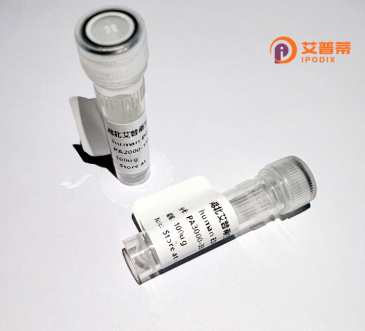
| 纯度 | >90%SDS-PAGE. |
| 种属 | Human |
| 靶点 | ALG3 |
| Uniprot No | Q92685 |
| 内毒素 | < 0.01EU/μg |
| 表达宿主 | E.coli |
| 表达区间 | 1-438aa |
| 氨基酸序列 | MAAGLRKRGRSGSAAQAEGLCKQWLQRAWQERRLLLREPRYTLLVAACLCLAEVGITFWVIHRVAYTEIDWKAYMAEVEGVINGTYDYTQLQGDTGPLVYPAGFVYIFMGLYYATSRGTDIRMAQNIFAVLYLATLLLVFLIYHQTCKVPPFVFFFMCCASYRVHSIFVLRLFNDPVAMVLLFLSINLLLAQRWGWGCCFFSLAVSVKMNVLLFAPGLLFLLLTQFGFRGALPKLGICAGLQVVLGLPFLLENPSGYLSRSFDLGRQFLFHWTVNWRFLPEALFLHRAFHLALLTAHLTLLLLFALCRWHRTGESILSLLRDPSKRKVPPQPLTPNQIVSTLFTSNFIGICFSRSLHYQFYVWYFHTLPYLLWAMPARWLTHLLRLLVLGLIELSWNTYPSTSCSSAALHICHAVILLQLWLGPQPFPKSTQHSKKAH |
| 分子量 | 76.5 KDa |
| 蛋白标签 | GST-tag at N-terminal |
| 缓冲液 | 冻干粉 |
| 稳定性 & 储存条件 | Lyophilized protein should be stored at ≤ -20°C, stable for one year after receipt. Reconstituted protein solution can be stored at 2-8°C for 2-7 days. Aliquots of reconstituted samples are stable at ≤ -20°C for 3 months. |
| 复溶 | Always centrifuge tubes before opening.Do not mix by vortex or pipetting. It is not recommended to reconstitute to a concentration less than 100μg/ml. Dissolve the lyophilized protein in distilled water. Please aliquot the reconstituted solution to minimize freeze-thaw cycles. |
1. **"Human ALG3 encodes a putative alpha-1.3-mannosyltransferase involved in N-glycan biosynthesis"**
- **作者**: Schwarz M, et al.
- **摘要**: 首次克隆并鉴定了人类ALG3基因,证明其编码的酶催化N-糖基化早期步骤中α-1.3-甘露糖的添加,酵母互补实验证实其功能保守性。
2. **"ALG3-CDG: A novel congenital disorder of glycosylation due to mutations in ALG3"**
- **作者**: Körner C, et al.
- **摘要**: 揭示了ALG3突变导致先天性糖基化障碍(CDG)的机制,患者表现为神经发育异常,突变引起脂联子Glc3Man5GlcNAc2-PP-Dol的合成缺陷。
3. **"Structural insights into human ALG3 catalysis using cryo-EM and molecular dynamics"**
- **作者**: Wang L, et al.
- **摘要**: 通过冷冻电镜解析了ALG3与底物复合物的三维结构,阐明了其催化α-1.3-甘露糖转移的活性位点及底物识别机制。
4. **"Functional characterization of human ALG3 in yeast: Role in lipid-linked oligosaccharide synthesis"**
- **作者**: Knauer R, Lehle L
- **摘要**: 在酵母模型中验证人源ALG3酶活性,证明其作用于Man5GlcNAc2-PP-Dol生成Man6GlcNAc2-PP-Dol,支持N-糖链前体合成的关键步骤。
ALG3 (Asparagine-Linked Glycosylation 3), also known as dolichyl-phosphate mannosyltransferase, is a key enzyme in the N-linked glycosylation pathway. Located in the endoplasmic reticulum (ER) membrane, it catalyzes the transfer of mannose from dolichyl-phosphate mannose (Dol-P-Man) to lipid-linked oligosaccharides (LLO), specifically forming the Man5GlcNAc2 intermediate. This step is critical for proper protein folding, cellular adhesion, and immune recognition.
ALG3 mutations are linked to congenital disorders of glycosylation (CDG), specifically ALG3-CDG (CDG-Id), characterized by severe neurodevelopmental abnormalities, seizures, and dysmorphic features. The enzyme’s dysfunction disrupts LLO assembly, leading to truncated glycans and defective glycoprotein trafficking. Beyond genetic diseases, ALG3 overexpression is observed in cancers, influencing tumor progression via glycosylation-dependent pathways such as EGFR signaling.
Structurally, ALG3 belongs to the glycosyltransferase family 1. requiring divalent cations for activity. Its regulatory role in ER quality control and cellular stress responses highlights its broader impact on proteostasis. Research continues to explore therapeutic strategies, including mannose supplementation or chaperone therapy, to rescue glycosylation defects in ALG3-related disorders.
×